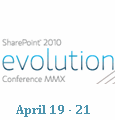The Scoop: SharePoint 2010 Records Management
 Guest Author: Mike Ferrara
Guest Author: Mike Ferrara
SharePointReviews.com
Last month, Alfresco announced that it had gained the distinction of being the first and only open-source software developer to achieve DoD 5015.02 records management (RM) certification.
Microsoft has been in compliance for years with DoD 5015.02, but they are in need of showing something new and competitive in SharePoint 2010’s RM offering.
Martin Tuip, Senior Technical Product Marketing Manager at Mimosa Systems, and Darrin Bishop, Darrin Bishop Group, tag-teamed a session at SPC09 on RM in SharePoint 2010 (news, site) to give us an idea of what changes have been made in the next release.
Editor’s Note: SharePoint 2007 has its 5015.2 Chapter 2 certification, not the full certification that Alfresco has.
What is Records Management
The session began with a brief description of what records management is and what constitutes a record. Wikipedia defines records management as “the practice of maintaining the records of an organization from the time they are created up to their eventual disposal.
This may include classifying, storing, securing, and destruction (or in some cases, archival preservation) or records.” The time that an organization considers information to be relevant or valuable is on a per case basis.
Although not always the case, a primary driving factor in records management is compliance with legal standards. A document or email becomes an item of record when it contains information about the running of the business, contains information that must be retained with statutory requirements or contains information about an employee or a potential employee.
Because judicial bodies can classify records as potential evidence in lawsuits, it is very important to include RM with your SharePoint deployments.
How SharePoint 2010 Improves on ERM
In Place Records Management
One of the new industry trends is the idea of in-place records management rather than a central repository of documents that requires a routing service. In this method, the documents stay in the current location, and they are classified as business records.
This will allow the document to gain the appropriate security, retention and disposition without ever having to be routed to a centrally managed location.
This saves IT resources and will more than likely decrease time spent during eDiscovery. New in SharePoint 2010 is the adoption of this technique, which will surely be a good choice for many organizations looking into RM.
Updates to Records Center
The live demo showed off the new slick, AJAX-friendly UI on top of the new Records Center site. For some organizations, the dedicated records center repository is more ideal, so Microsoft has given the site a major face-lift.
Not only is it a lot easier to submit a record (as seen below by the large “Submit a Record” button), but the overall layout of the site is cleaner. You can also search for document IDs right on the main page.
During the demo Darrin Bishop showed us how he created new content types with information rights management (IRM) configured. He was able to very quickly set up retention stages for multiple scenarios relating to documents.
One stage created was one that would delete all previous drafts of a document 3 years after the document was created. Another was a stage that would move the document to the recycle bin after a lifecycle of 7 years.
Auditing, barcodes and labels have been retained from the features seen in SharePoint 2007.

SharePoint 2010 – Records Management
The big push in this release is for greater adoption from end users themselves. The Records Center site has been redesigned so that it is easier for a records manager to maintain the order of the site. The RM configuration page displays step-by-step instructions to guide the user in how to properly setup the hierarchy.
Content Organizer
The routing rules from 2007 have been replaced by the content organizer, which is actually a new SharePoint feature available in all document libraries. The content organizer is used to route documents to the right folder based on content types and any other metadata that you require. The takeaway here is that folders have been given a whole “new” spin in SharePoint 2010.
Changes to Folders
Folders have no functionality in 2007, and the standard best practice is to avoid them in most situations and use metadata columns instead. For 2010, folders will now be able to act as true parents to any child objects below it.
The idea now is to set metadata at the folder level, so that the child objects can inherit that information. So as this may not be new to anyone familiar with other popular DMS/CMS solutions, this is a completely different approach from Microsoft that is already being applauded.

Compliance Details
Another new feature is that every document in SharePoint 2010 now has a “compliance details” option on the context menu. This allows you to check out all the relevant settings that have been applied to a specific business record.
This looks like a great feature that will easily allow administrators to make sure that specific documents are inheriting the right policies and retention settings.
As with most context menus in SharePoint 2010, you won’t have to leave the page to see this information, and you’ll even be able to change the exemption and/or hold status based on what you see here.

SharePoint 2010 Compliance Details
eDiscovery
These new and improved features all come together to help attain a higher efficiency when relating to eDiscovery, which is the process of discovering electronically stored data. Because there is a set of Federal rules (Federal Rules of Civil Procedure) that govern the request of information in litigation, it is very important to be able to produce electronic data when requested in a court of law.
It is also important that the data is accompanied along with the metadata that was associated with it in the system.
In SharePoint 2010, content types are now service-based rather than being tied to a site or site collection. Content types will automatically be available in all sites throughout the farm, so there is no need to deploy content types to separate site collections.
Since records are tied to content types, the time required to get a records management solution up and running in SharePoint has been greatly reduced across the board.
New in SharePoint 2010
- In-place Records Management
- Document Sets
- Persistent Document IDs
- Content Organizer
- Compliance Details Menu Option
Improved in SharePoint 2010
- Record Center Site Definition
- Record Center Management Interface
- Document Routing
- Information Policies
Recap
We are only scratching the surface here for what will eventually be in the RTM version of 2010, but this was a good overview of what’s to come.
Support for in-place RM within all libraries is a major plus if you are looking for SharePoint 2010 to be your solution. Not only does this reduce IT overhead, but it allows your end users to live in the appropriate libraries for all relevant information. They won’t have to leave the confines of their collaborative environment to find a business record that relates to their project.
But for organizations that rely on dedicated librarians, the existing records center site from 2007 has been greatly enhanced visually and structurally.
We are still in early beta stages with 2010, so some of this information is subject to change. But enough has been shown here to prove that Microsoft is not putting RM on the back burner with the new release.
 Guest Author: Mike Ferrara
Guest Author: Mike Ferrara
SharePointReviews.com
Mike Ferrara is an independent consultant and editor with SharePointReviews.com. He specializes in document and content management systems including SharePoint and the Autonomy/Interwoven family of products.





Very informative … looking forward to playing around with Records Management in 2010
Hi, I was suprised to read, that someone was able to enable Information Rights Management capabilities for a content type. That sound great but I cant discover the properties for that. I think you meant that he created information management policies (like retention and so on). Am I right?
Thanx
Wojciech
“Microsoft has been in compliance for years with DoD 5015.02″
Please look at the compliance lists before making broad sweeping remarks.
In order for Sharpoint 2007 to be DoD 5015.02 compliant, the customer had to get an addon from microsoft and that addon is no longer compliant.
According to JITC SharePoint 2007 DoD compliance (with the dod kit addon) expired in may of 2009
http://jitc.fhu.disa.mil/recmgt/register.html
There are vendors on the list that use Sharepoint, but they are compliant because they use their own records management tool with it.